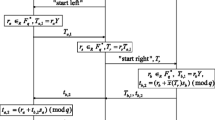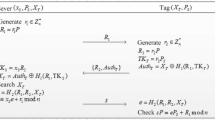Abstract
The low birth rate has led to an aging society; the burgeoning number of elderly patients may affect the medical quality and result in negative medical incidents. There are many factors that lead to medical errors, such as similar medication names, erroneous labels and packaging, as well as staff shortages, fatigue and carelessness. Determining how to reduce medical errors has become an important issue. As RFID exhibits powerful identification characteristics, it can help nurses to quickly identify patients and their corresponding medicine. Currently, there are numerous practical applications for improving the efficiency of Radio Frequency Identification (RFID) systems. In this paper, we use an RFID yoking proof mechanism which conforms to EPCglobal Class 1 Generation 2 standards to improve patient safety and reduce medical errors. Our scheme can achieve different goals such as resist numerous known attacks, achieve mutual authentication, anonymity and non-repudiation. It also provides a practical medical care and offer higher quality of medical care. The pharmacist cannot deny that this prescription was confirmed for the patient and the nurse cannot also deny he or she dispensed this medicine to the patient for protecting the patients’ interests.




Similar content being viewed by others
References
Institute of Medicine of the National Academies. Website: http://www.iom.edu/Reports.aspx. (Access available on 24 May 2011).
Hickner, J., Zafar, A., Kuo, G. M., et al., Field test results of a new ambulatory care medication error and adverse drug event reporting system—MEADERS. Ann. Fam. Med. 8:517–525, 2010.
Miller, A. D., Piro, C. C., Rudisill, C. N., Bookstaver, P. B., Bair, J. D., and Bennett, L. C., Nighttime and weekend medication error rates in an inpatient pediatric population. 19 Oct. 2010. http://www.theannals.com, doi:10.1345/aph.1P252 (Access available on 24 May 2011).
Berman, A., Reducing medication errors through naming, labeling, and packaging. J. Med. Syst. 28(1):9–29, 2004.
Crawford, S. Y., Cohen, M. R., and Tafesse, E., Systems factors in the reporting of serious medication errors in hospitals. J. Med. Syst. 27(6):543–551, 2003.
Walton, S. M., The pharmacist shortage and medication errors: issues and evidence. J. Med. Syst. 28(1):59–63, 2004.
Shojania, K. G., Duncan, B. W., McDonald, K. M., et al., Safe but sound: Patient safety meets evidence-based medicine. J. Am. Med. Assoc. 288:508–513, 2002.
Chung, K., Choi, Y. B., and Moon, S., Toward efficient medication error reduction: Error-reducing information management systems. J. Med. Syst. 27(6):533–560, 2003.
Klaus, F., RFID handbook: Fundamentals and applications in contactless smart Cards, Radio Frequency Identification and Near-Field Communication. Wiley, Third Edition, 2010.
Taichung Hospital Website: http://www.taic.doh.gov.tw/english/ (Access available on 24 May 2011).
Chen, P. J., Chen, Y. F., Chai, S. K., and Huang, Y. F., Implementation of an RFID-based management system for operation room. Int. Conf. Mach. Learn. Cybern.:2933–2938, Baoding, 12–15 Jul, 2009.
Frisch, P., Miodownik, S., Booth, P., Carragee, P., and Dowling, M., Patient centric identification and association. Annu. Int. Conf. IEEE Eng. Med. Biol. Soc.:1722–1725, Minneapolis, MN, 3–6 Sep. 2009.
Juels, A., Yoking-proofs for RFID tags, Proceedings of the Second IEEE Annual Conference on Pervasive Computing and Communications Workshops.:138–143, 14–17 Mar, 2004.
Saito, J., and Sakurai, K., Grouping proof for RFID tags, 19th International Conference on Advanced Information Networking and Applications.:621–624, 28–30 Mar, 2005.
Piramuthu, S., On existence proofs for multiple RFID Tags. IEEE Int. Conf. Pervasive Serv.:317–320, Jun. 2006.
Lin, C. C., Lai, Y. C., Tygar, J. D., Yang, C. K., and Chiang, C. L., Coexistence proof using chain of timestamps for multiple RFID tags. In Web Netw. Tech. Inform. Manag. 4537:634–643, 2007.
Burmester, M., Medeiros, B., and Motta, R., Provably secure grouping-proofs for RFID tags. Lect. Notes. Comput. Sci. 5189:176–190, 2008.
Chien, H. Y., and Liu, S. B., Tree-based RFID yoking proof. Int. Conf. Network Secur. Wireless Comm. Trusted Comput.:550–553, Wuhan, Hubei, 25–26 Apr, 2009.
Wu, F., Kuo, F., and Liu, L. W., The application of RFID on drug safety of inpatient nursing healthcare, the 7th International Conference on Electronic Commerce.:85–92, New York, USA, 2005.
Sun, P. R., Wang, B. H., and Wu, F., A new method to guard inpatient medication safety by the implementation of RFID. J. Med. Syst. 32(4):327–332, 2008.
Huang, H.-H., and Ku, C.-Y., A RFID grouping proof protocol for medication safety of inpatient. J. Med. Syst. 33(6):467–474, 2009.
Chien, H.-Y., Yang, C.-C., Wu, T.-C., and Lee, C.-F., Two RFID-based solutions to enhance inpatient medication safety. J. Med. Syst. 35(3):369–375, 2011.
Pedro, P. L., Agustin, O., Julio, C. H. C., and Jan, C. A. V. L., 2010. Flaws on RFID grouping-proofs guidelines for future sound protocols, J. Netw. Comput. Appl. 34(3):833–845, 2011.
Yu, Y-C., Hou, T-W., and Chiang, T-C., Low cost RFID real lightweight binding proof protocol for medication errors and patient safety. J. Med. Syst. doi:10.1007/s10916-010-9546-4. (Access available on 24 May 2011).
Pedro, P.-L., Agustin, O., Aikaterini, M., and Jan, C. A. V. L., A comprehensive RFID solution to enhance inpatient medication safety. Int. J. Med. Informat. 80(1):13–24, 2011.
Benjamin, D. M., Reducing medication errors and increasing patient safety: case studies in clinical pharmacology. J. Clin. Pharmacol. 43(7):768–783, 2003.
Tseng, Y. M., Jan, J. K., and Chien, H. Y., On the security of generalization of threshold signature and authenticated encryption. IEICE Trans. Fund. Electron. Comm. Comput. E84-A(10):2606–2609, 2001.
EPCglobal, Inc., website: http://www.epcglobalinc.org/. (Access available on 24 May 2011).
Author information
Authors and Affiliations
Corresponding author
Rights and permissions
About this article
Cite this article
Chen, CL., Wu, CY. Using RFID Yoking Proof Protocol to Enhance Inpatient Medication Safety. J Med Syst 36, 2849–2864 (2012). https://doi.org/10.1007/s10916-011-9763-5
Received:
Accepted:
Published:
Issue Date:
DOI: https://doi.org/10.1007/s10916-011-9763-5




